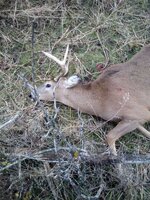- Nov 4, 2004
- 26,803
- 12,869
FWIW, I have had similar results on WT deer using the ABLR's...
280AI 150 gr
308 Win 168 gr
30 Nosler 168 gr
338 RUM 265 gr and 300 gr
Although most are DRT kills, the off side landscape is littered with biological matter.
JD338
280AI 150 gr
308 Win 168 gr
30 Nosler 168 gr
338 RUM 265 gr and 300 gr
Although most are DRT kills, the off side landscape is littered with biological matter.
JD338





